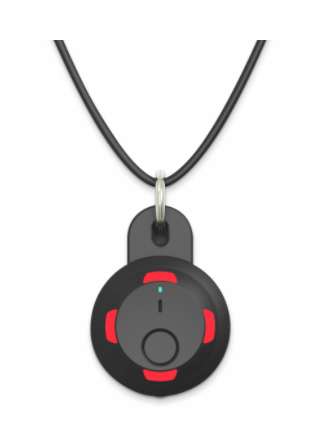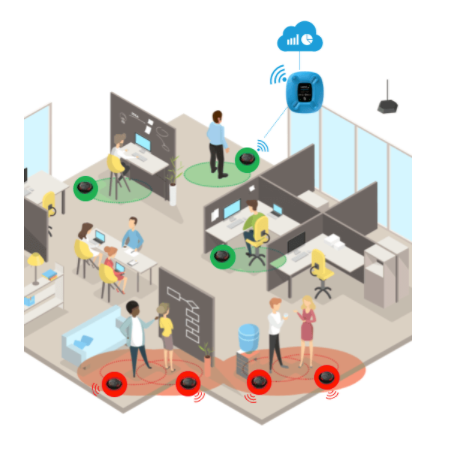Written by Jonathan Kaye, Senior Director, Product Management, Laird Connectivity
This post originally ran on the Laird Connectivity website. For more content like this, visit https://www.lairdconnect.com/resources/blog.
A Public Health Crisis in the Age of Smart Solutions
When COVID-19 emerged as a pandemic this Spring, governments around the world met the news and the challenge in many different ways. Approaches to limiting infections have been driven by known disease vectors for COVID-19, and while there’s still more to learn about the behavior of the virus, one of the most common methods of attempting to limit the spread has been to encourage widespread social distancing.
The principle behind social distancing is clear and simple: since the COVID-19 virus appears to spread primarily through person-to-person contact, keeping a safe distance from others (in addition to secondary measures like face masks) has been shown to have a profound impact on virus spread. And since the virus doesn’t survive well on hard surfaces, eliminating this main vector of spread is enough to dramatically slow infections and results in better outcomes for public health.
Another strategy is contact tracing, which means attempting to reconstruct thef contacts made by a person who has become infected. While effective, it’s often very difficult to build a reliable timeline of who an infected person has been exposed to. People aren’t necessarily able to recall everyone they’ve been around and may not be aware in the first place.
However, as more governments, schools, workplaces, and others explore options for resuming public life in shared public spaces, it has also become obvious that human error and indoor environments make it difficult, if not sometimes nearly impossible, to consistently practice the caution needed to produce those results. As with so many other problems like this, the best and most reliable solutions lie within the realm of the Internet of Things (IoT) – Laird Connectivity’s Sentrius™ BT710 wearable tracker/multi-sensor, which is based on Zephyr RTOS, is a great way to automate and simplify the challenges of social distancing and contact tracing.
Example: Campuses of Thousands Struggling to Maintain Distance
Perhaps nowhere is the challenge more pronounced than in large college campuses, which by their very nature tend to expose students, faculty, and others to repeated contact and proximity to others. Campuses function on a schedule of moving between buildings and classes, and often feature open areas of congregation and large indoor study and dining halls. In a campus, it can be practically impossible to fully avoid exposure to others, and since learning and teaching involve person-to-person interactions by default, the potential for human error and closer-than-intended exposure is high.
There is a great potential for IoT to solve this challenge, particularly by using wearable technology to encourage and alert users when they’ve approached too closely. Our Sentrius™ BT710 tracker is an elegant solution to this problem: with several wearable form factors (clip/pendant/wristband) and alerts (LED/vibration), the BT710 can sense when it’s too close to other BT710 sensors and trigger warnings to the user, serving as a reminder to the wearer to keep a safe distance.
This is enough to facilitate social distancing, but contact tracing introduces another challenge. In order to build a timeline for contact tracing, it’s necessary to log all instances of contact, so that if someone is infected, the people they’ve been exposed to can be notified and checked for illness. This means contact data needs to be logged on the sensor, and then uploaded somehow to the cloud for analysis.

This is where our Sentrius™ MG100 Bluetooth / Cellular micro-gateway has a role. Placed strategically around a campus, the MG100 can serve as a gateway for sensor data. Whenever BT710 sensors come into range of the MG100, they can upload their logged events, and the MG100 can route that via cellular to a cloud application that can help establish linkage and identify people who have come into contact with an infected person.
Since the MG100 operates over cellular, there’s no need to run ethernet cable. The MG100 can be easily mounted in common areas where it can gather data from many, many sensors easily and then relay to the cloud. By offloading this functionality to a gateway instead of requiring cellular connectivity within the sensor itself, this solution is lower in cost than an alternative and more expensive wearable sensor.
Most importantly, this solution is completely frictionless to the end user. There’s no required action on the part of students or faculty, other than to wear the sensor. There’s no need to manually upload data, interact with the device, or to do anything else. As long as administrators place gateways in bounding areas around the campus where students and faculty are certain to pass (parking areas, dormitories, dining areas, and more), there is no need for action on the part of the user. This means the sensors work continuously (powered by a long-lasting button battery) and are not vulnerable to user error, such as forgetting to log data or failure to charge the battery.
Learn more about our Sentrius™ BT710 Sensor and Sentrius™ MG100 Gateway.

Example: Busy Manufacturing Floors Leave Room for Error
In manufacturing environments, busy production and lots of moving parts create an environment where social distancing can be especially difficult. Workers interacting, moving parts, transferring between work areas and trying to maintain tight deadlines are all factors that can create accidental contact and possibly spread disease. Once again, the BT710 provides a solution that cuts through the routine and helps enforce social distancing where it’s easy to forget safe procedure.
The BT710’s vibration functionality is ideal for environments like these, which can be noisy and can make it difficult to hear an audio alert. Workers can also utilize a hard-hat clip, which can keep the BT710 away from manufactured parts that can be susceptible to scratches and physical damage that can result from a wrist-worn sensor or pendant.
For industrial environments, the Sentrius™ IG60 Gateway is uniquely suited to the demand for rugged equipment, with a wide range of ways to connect. The IG60 supports Ethernet, Wi-Fi 802.11ac, Serial, and LTE. The IG60 is available with built-in AWS IoT Greengrass support, which allows you to easily write lambda applications to send your data to AWS and start monitoring and tracking sensor data.
The IG60 gives you more options for the ultimate in design flexibility. Skip cellular data fees by connecting directly to Wi-Fi or Ethernet. Back up data locally on a Micro SD card in case of outages. Mount to existing infrastructure with DIN-Rail mount, or to any wall with the included wall mount bracket. And connect with reliability, thanks to high-performance 2×2 MIMO Wi-Fi.
All of these features make the BT710 and IG60 a winning combination for monitoring the health and safety of your installations. The best social distancing and contact tracing solutions have to work continuously, leaving no contact unconfirmed and reliably getting that information to the cloud for crucial alerts. The BT710 and the IG60 give you confidence that your workers are protected in real-time.
Smart Contact Tracing, Thanks to the IoT
The Internet of Things is powering the smart solutions of the future, and Laird Connectivity is helping bridge that gap. Our line of IoT Gateways and Sensors are designed for rapid deployment, unparalleled performance, and total reliability. They feature the latest wireless technology, including Bluetooth 5, LTE-M/NB-IoT, LoRaWAN, Wi-Fi 802.11ac, and more. They’re designed with the advantage of our three decades of wireless design expertise, they’re fully customizable, and they are certified for worldwide regulatory markets.
Our wireless experts are ready to help bring your design from concept to reality.